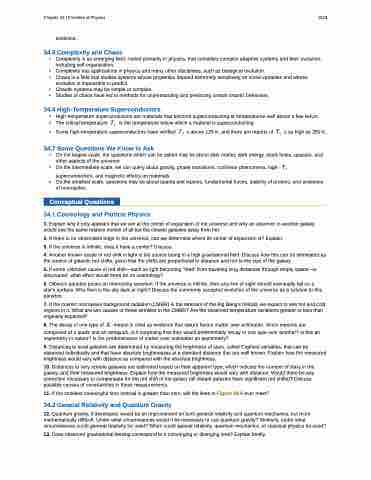Page 1555 - College Physics For AP Courses
P. 1555
Chapter 34 | Frontiers of Physics 1543
evidence.
34.5 Complexity and Chaos
• Complexity is an emerging field, rooted primarily in physics, that considers complex adaptive systems and their evolution, including self-organization.
• Complexity has applications in physics and many other disciplines, such as biological evolution.
• Chaos is a field that studies systems whose properties depend extremely sensitively on some variables and whose
evolution is impossible to predict.
• Chaotic systems may be simple or complex.
• Studies of chaos have led to methods for understanding and predicting certain chaotic behaviors.
34.6 High-Temperature Superconductors
• High-temperature superconductors are materials that become superconducting at temperatures well above a few kelvin.
• The critical temperature �� is the temperature below which a material is superconducting.
• Some high-temperature superconductors have verified �� s above 125 K, and there are reports of �� s as high as 250 K.
34.7 Some Questions We Know to Ask
• On the largest scale, the questions which can be asked may be about dark matter, dark energy, black holes, quasars, and other aspects of the universe.
• On the intermediate scale, we can query about gravity, phase transitions, nonlinear phenomena, high- ��
superconductors, and magnetic effects on materials.
• On the smallest scale, questions may be about quarks and leptons, fundamental forces, stability of protons, and existence
of monopoles.
Conceptual Questions
34.1 Cosmology and Particle Physics
1. Explain why it only appears that we are at the center of expansion of the universe and why an observer in another galaxy would see the same relative motion of all but the closest galaxies away from her.
2. If there is no observable edge to the universe, can we determine where its center of expansion is? Explain. 3. If the universe is infinite, does it have a center? Discuss.
4. Another known cause of red shift in light is the source being in a high gravitational field. Discuss how this can be eliminated as the source of galactic red shifts, given that the shifts are proportional to distance and not to the size of the galaxy.
5. If some unknown cause of red shift—such as light becoming “tired” from traveling long distances through empty space—is discovered, what effect would there be on cosmology?
6. Olbers's paradox poses an interesting question: If the universe is infinite, then any line of sight should eventually fall on a star's surface. Why then is the sky dark at night? Discuss the commonly accepted evolution of the universe as a solution to this paradox.
7. If the cosmic microwave background radiation (CMBR) is the remnant of the Big Bang's fireball, we expect to see hot and cold regions in it. What are two causes of these wrinkles in the CMBR? Are the observed temperature variations greater or less than originally expected?
8. The decay of one type of � -meson is cited as evidence that nature favors matter over antimatter. Since mesons are composed of a quark and an antiquark, is it surprising that they would preferentially decay to one type over another? Is this an
asymmetry in nature? Is the predominance of matter over antimatter an asymmetry?
9. Distances to local galaxies are determined by measuring the brightness of stars, called Cepheid variables, that can be observed individually and that have absolute brightnesses at a standard distance that are well known. Explain how the measured brightness would vary with distance as compared with the absolute brightness.
10. Distances to very remote galaxies are estimated based on their apparent type, which indicate the number of stars in the galaxy, and their measured brightness. Explain how the measured brightness would vary with distance. Would there be any correction necessary to compensate for the red shift of the galaxy (all distant galaxies have significant red shifts)? Discuss possible causes of uncertainties in these measurements.
11. If the smallest meaningful time interval is greater than zero, will the lines in Figure 34.9 ever meet? 34.2 General Relativity and Quantum Gravity
12. Quantum gravity, if developed, would be an improvement on both general relativity and quantum mechanics, but more mathematically difficult. Under what circumstances would it be necessary to use quantum gravity? Similarly, under what circumstances could general relativity be used? When could special relativity, quantum mechanics, or classical physics be used?
13. Does observed gravitational lensing correspond to a converging or diverging lens? Explain briefly.


